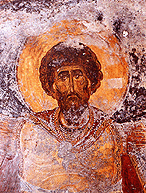 |
|
 |
The Peloponnese
 fter the defeat of
William de Villehardouin
at the
battle of Pelagonia
in 1259 and the cession of four Peloponnesian fortresses (Mistra, Mani,
fter the defeat of
William de Villehardouin
at the
battle of Pelagonia
in 1259 and the cession of four Peloponnesian fortresses (Mistra, Mani,
 Monemvasia and Geraki) to the Byzantine Emperor Michael VIII Palaiologos, the southern Peloponnese little by little passed into the hands of the Byzantines. One of the first mural ensembles connected to the presence of the Byzantine expeditionary forces in the area, is that of the SS. Theodore at Kafiona in the Mani. These superb frescoes, which stylistically correspond to the developments in painting of the great metropolitan centres, surprise the present-day visitor of this small provincial church. The donor inscription informs us that the patrons were high-standing church dignitaries and that the paintings were created "during the rule...in the land of the Pollyponisos (sic) of the
sebastokrator
Constantine Paleologos". Monemvasia and Geraki) to the Byzantine Emperor Michael VIII Palaiologos, the southern Peloponnese little by little passed into the hands of the Byzantines. One of the first mural ensembles connected to the presence of the Byzantine expeditionary forces in the area, is that of the SS. Theodore at Kafiona in the Mani. These superb frescoes, which stylistically correspond to the developments in painting of the great metropolitan centres, surprise the present-day visitor of this small provincial church. The donor inscription informs us that the patrons were high-standing church dignitaries and that the paintings were created "during the rule...in the land of the Pollyponisos (sic) of the
sebastokrator
Constantine Paleologos".
Professor N. Drandakis,
who studied these wall paintings, has suggested a date for them between 1264 and 1270, that is the period during which the brother of
Michael VIII Palaiologos
, the sebastokrator Constantine mentioned in the inscription, was in the region at the head of the expeditionary corps that brought the Peloponnese once again under Byzantine domination. The exceptionally fine quality of the wall paintings, which belong to the new current of the "volume style", led Professor Drandakis to attribute them to some painter who must have belonged to the expeditionary corps and must have come from Constantinople. Thus, the innovative tendencies in art penetrated into the Peloponnese, and took root in new artistic centres such as Mistra. These tendencies evolved at the same time as in the large centres, or were translated into a local style strongly reminiscent of
Late Komnenian art,
a development mostly observed in the monuments of the Mani, the number of which increases during the second half of the 13th century.
See also : The recovery of Constantinople
|